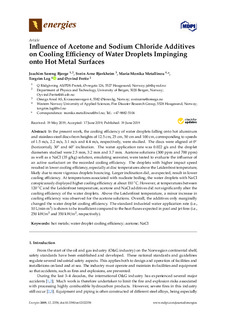| dc.contributor.author | Bjørge, Joachim Søreng | |
| dc.contributor.author | Bjørkheim, Svein Arne | |
| dc.contributor.author | Log, Maria-Monika Metallinou | |
| dc.contributor.author | Log, Torgrim | |
| dc.contributor.author | Frette, Øyvind | |
| dc.date.accessioned | 2019-08-19T11:14:23Z | |
| dc.date.available | 2019-08-19T11:14:23Z | |
| dc.date.created | 2019-06-22T08:56:03Z | |
| dc.date.issued | 2019 | |
| dc.identifier.citation | Bjørge, J. S., Bjørkheim, S. A., Metallinou, M.-M., Log, T., & Frette, Ø. (2019). Influence of acetone and sodium chloride additives on cooling efficiency of water droplets impinging onto hot metal surfaces. Energies, 12(12) | nb_NO |
| dc.identifier.issn | 1996-1073 | |
| dc.identifier.uri | http://hdl.handle.net/11250/2609001 | |
| dc.description.abstract | In the present work, the cooling efficiency of water droplets falling onto hot aluminum and stainless steel discs from heights of 12.5 cm, 25 cm, 50 cm and 100 cm, corresponding to speeds of 1.5 m/s, 2.2 m/s, 3.1 m/s and 4.4 m/s, respectively, were studied. The discs were aligned at 0° (horizontal), 30° and 60° inclination. The water application rate was 0.022 g/s and the droplet diameters studied were 2.5 mm, 3.2 mm and 3.7 mm. Acetone solutions (300 ppm and 700 ppm) as well as a NaCl (35 g/kg) solution, emulating seawater, were tested to evaluate the influence of an active surfactant on the recorded cooling efficiency. The droplets with higher impact speed resulted in lower cooling efficiency, especially at disc temperatures above the Leidenfrost temperature, likely due to more vigorous droplets bouncing. Larger inclination did, as expected, result in lower cooling efficiency. At temperatures associated with nucleate boiling, the water droplets with NaCl conspicuously displayed higher cooling efficiency at about 110 °C. However, at temperatures between 120 °C and the Leidenfrost temperature, acetone and NaCl additives did not significantly alter the cooling efficiency of the water droplets. Above the Leidenfrost temperature, a minor increase in cooling efficiency was observed for the acetone solutions. Overall, the additives only marginally changed the water droplet cooling efficiency. The standard industrial water application rate (i.e., 10 L/min∙m2) is shown to be insufficient compared to the heat fluxes expected in pool and jet fires (i.e., 250 kW/m2 and 350 kW/m2, respectively). | nb_NO |
| dc.language.iso | eng | nb_NO |
| dc.publisher | MDPI | nb_NO |
| dc.rights | Navngivelse 4.0 Internasjonal | * |
| dc.rights.uri | http://creativecommons.org/licenses/by/4.0/deed.no | * |
| dc.subject | hot metals | nb_NO |
| dc.subject | water droplet cooling efficiency | nb_NO |
| dc.subject | acetone | nb_NO |
| dc.subject | NaCl | nb_NO |
| dc.title | Influence of Acetone and Sodium Chloride Additives on Cooling Efficiency of Water Droplets Impinging onto Hot Metal Surfaces | nb_NO |
| dc.type | Journal article | nb_NO |
| dc.type | Peer reviewed | nb_NO |
| dc.description.version | publishedVersion | nb_NO |
| dc.rights.holder | © 2019 by the authors. | nb_NO |
| dc.source.pagenumber | 16 | nb_NO |
| dc.source.volume | 12 | nb_NO |
| dc.source.journal | Energies | nb_NO |
| dc.source.issue | 12 | nb_NO |
| dc.identifier.doi | 10.3390/en12122358 | |
| dc.identifier.cristin | 1707000 | |
| cristin.unitcode | 203,12,2,0 | |
| cristin.unitname | Institutt for brannsikkerheit og HMS | |
| cristin.ispublished | true | |
| cristin.fulltext | original | |
| cristin.qualitycode | 1 | |

